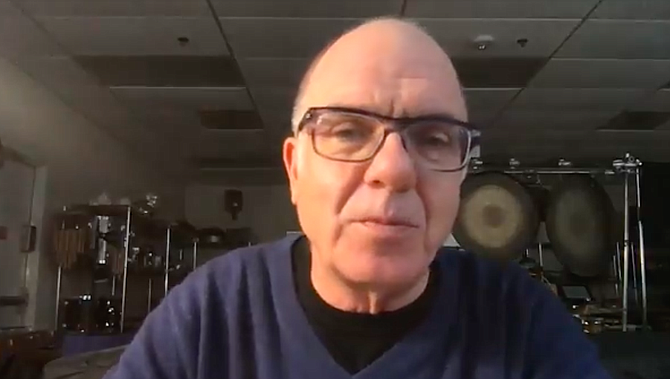 Facebook
Facebook
 X
X
 Instagram
Instagram
 TikTok
TikTok
 Youtube
Youtube

The La Jolla Symphony recently released a performance of Sibelius’s Symphony No. 5 from their performance vault. I gave it a listen and have concluded that it is a fine, fine, performance.
For those who are not familiar with The La Jolla Symphony, it is an amateur orchestra that is associated with UC San Diego. They have a tradition of presenting large-scale masterpieces such as Mahler’s Fifth Symphony, Verdi’s Requiem, Benjamin Britten’s War Requiem, Berlioz’s Requiem, and Dona Nobis Pacem by Ralph Vaughan Williams.
Prior to this video presentation of Sibelius, La Jolla Symphony Music Director Steven Schick essayed the symphony in poetic terms and tied it into the season of late November. Schick explored the cycle of the seasons and the journey from autumn to spring.
Following Maestro Schick’s lead, I find this performance to be idiomatic to the season of Advent as we move toward the rebirth of the sun—Sol Invictus. Sibelius’s symphony is very much a journey from darkness to light.
Nowhere is this more evident than in the three-note ostinato figure that starts in the brass at the 36:36 mark of the video and continues to develop until the symphony concludes with five strokes of Thor’s hammer. This is one of the greatest moments in the symphonic repertoire and the La Jollans executed it magnificently.
I’ve not been to every single La Jolla Symphony concert, but the ones I’ve been able to attend have been sturdy events of music-making. Maestro Schick has developed this group of students, doctors, lawyers, and engineers into a pillar of San Diego’s cultural Parthenon.
The 2020-2021 season is still breathing in La Jolla with concerts scheduled to start in February. They are offering several modern and contemporary compositions but a few items stand out. In April there is a concert juxtaposing the works of J.S. Bach and Oliver Messian. That should be an interesting concert, but there is a massive shadow being cast over the entire season.
That shadow belongs to Gustav Mahler’s Symphony No. 2: Resurrection. It is scheduled for June and the idea of hearing that gargantuan symphony within the somewhat intimate confines of Mandeville Auditorium is beyond exciting.
This might be the only chance some of us will ever have to hear this symphony live in San Diego. The San Diego Symphony performed it a few decades ago and there is no telling when or if it will come around again.
My new Christmas wish is to hear Maher Two at the La Jolla Symphony. I hope Santa is listening.


The La Jolla Symphony recently released a performance of Sibelius’s Symphony No. 5 from their performance vault. I gave it a listen and have concluded that it is a fine, fine, performance.
For those who are not familiar with The La Jolla Symphony, it is an amateur orchestra that is associated with UC San Diego. They have a tradition of presenting large-scale masterpieces such as Mahler’s Fifth Symphony, Verdi’s Requiem, Benjamin Britten’s War Requiem, Berlioz’s Requiem, and Dona Nobis Pacem by Ralph Vaughan Williams.
Prior to this video presentation of Sibelius, La Jolla Symphony Music Director Steven Schick essayed the symphony in poetic terms and tied it into the season of late November. Schick explored the cycle of the seasons and the journey from autumn to spring.
Following Maestro Schick’s lead, I find this performance to be idiomatic to the season of Advent as we move toward the rebirth of the sun—Sol Invictus. Sibelius’s symphony is very much a journey from darkness to light.
Nowhere is this more evident than in the three-note ostinato figure that starts in the brass at the 36:36 mark of the video and continues to develop until the symphony concludes with five strokes of Thor’s hammer. This is one of the greatest moments in the symphonic repertoire and the La Jollans executed it magnificently.
I’ve not been to every single La Jolla Symphony concert, but the ones I’ve been able to attend have been sturdy events of music-making. Maestro Schick has developed this group of students, doctors, lawyers, and engineers into a pillar of San Diego’s cultural Parthenon.
The 2020-2021 season is still breathing in La Jolla with concerts scheduled to start in February. They are offering several modern and contemporary compositions but a few items stand out. In April there is a concert juxtaposing the works of J.S. Bach and Oliver Messian. That should be an interesting concert, but there is a massive shadow being cast over the entire season.
That shadow belongs to Gustav Mahler’s Symphony No. 2: Resurrection. It is scheduled for June and the idea of hearing that gargantuan symphony within the somewhat intimate confines of Mandeville Auditorium is beyond exciting.
This might be the only chance some of us will ever have to hear this symphony live in San Diego. The San Diego Symphony performed it a few decades ago and there is no telling when or if it will come around again.
My new Christmas wish is to hear Maher Two at the La Jolla Symphony. I hope Santa is listening.
Comments